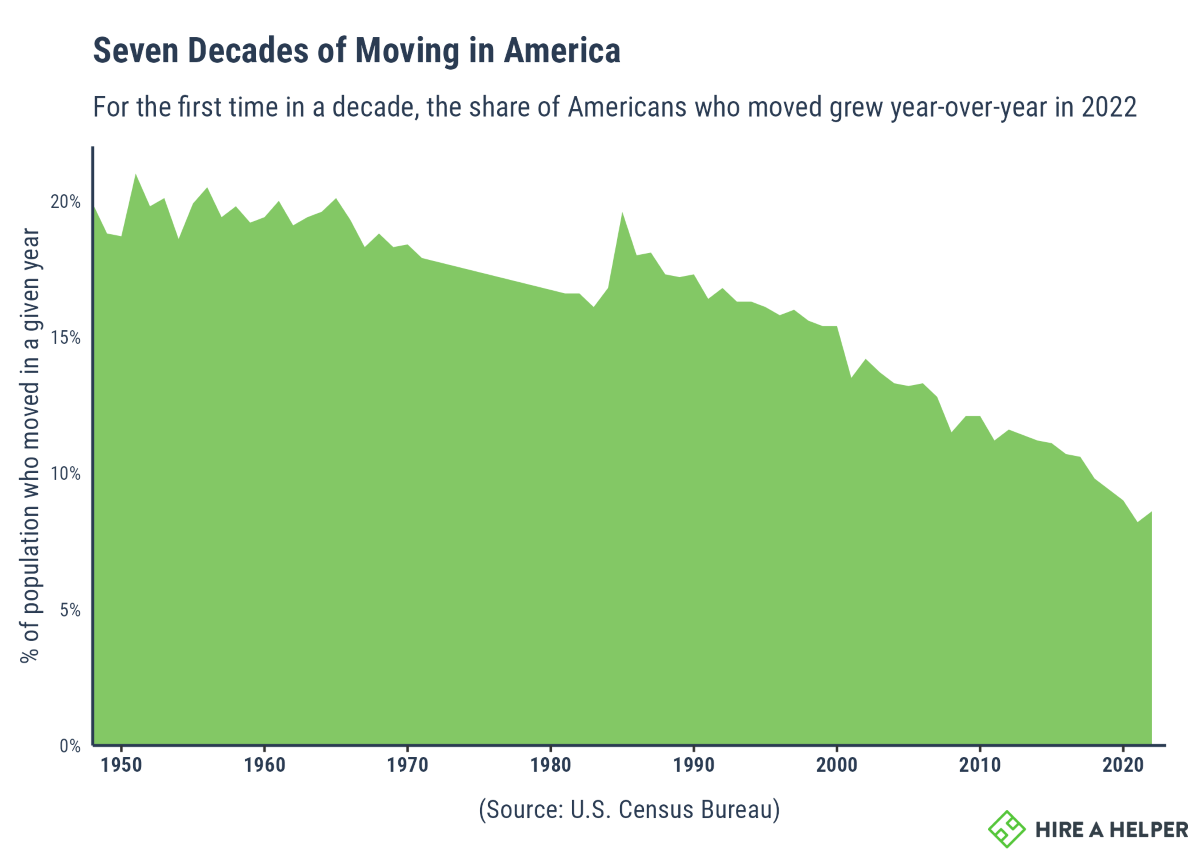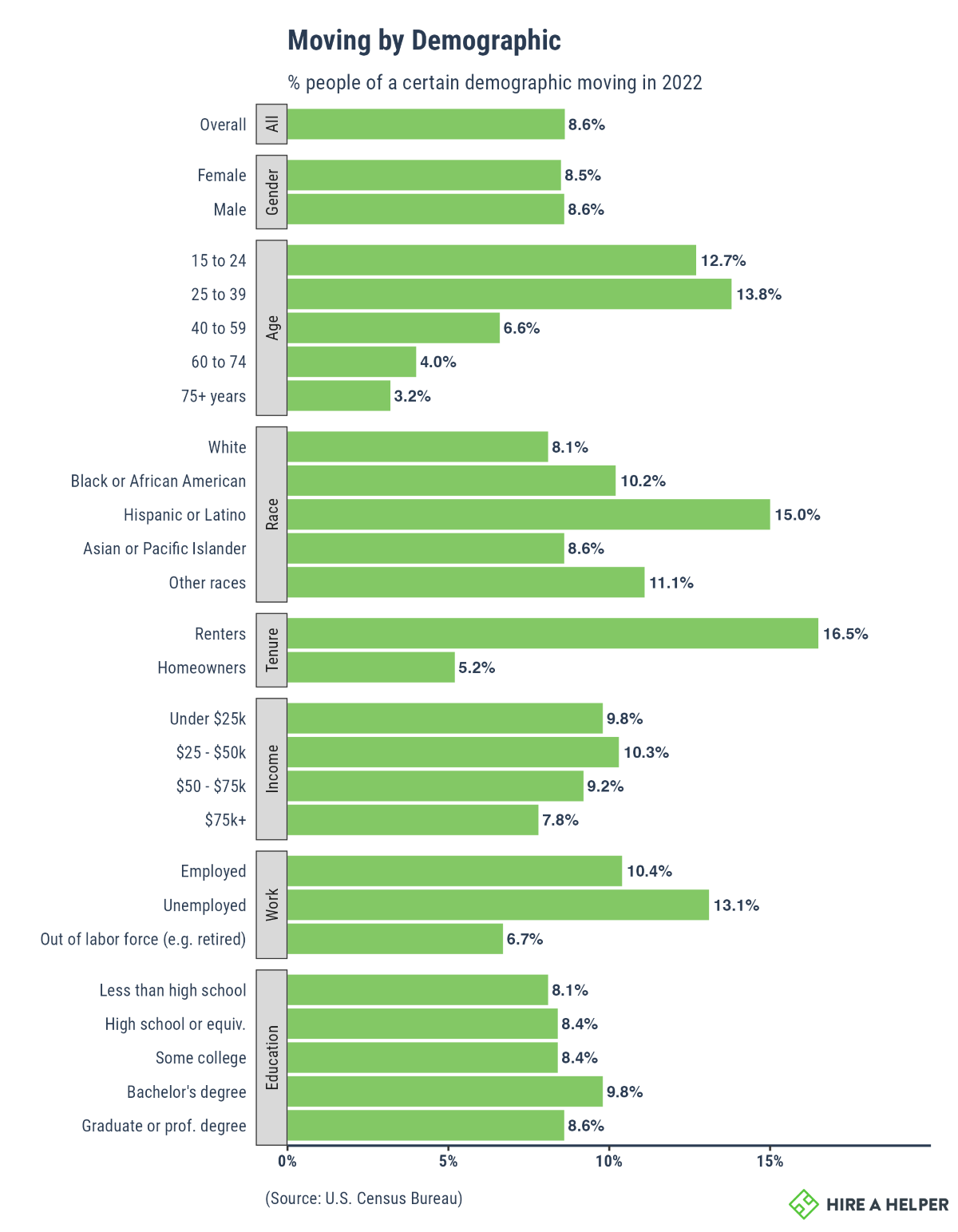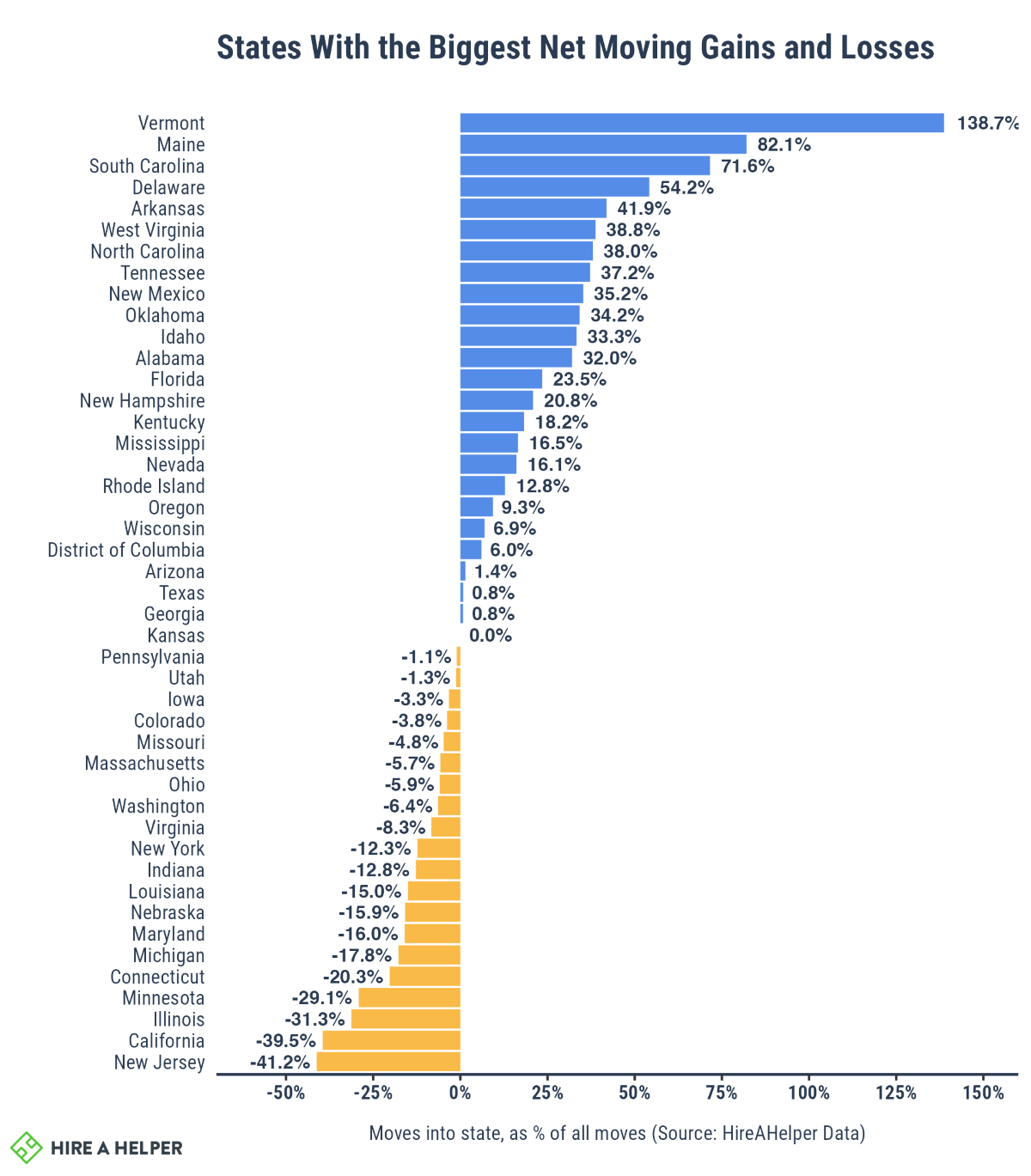32+ Key Moving Statistics You Should Know in 2023
(updated Mar 2023)
Welcome to the web's most comprehensive hub for every major relocation study in America: migration reports and government census data. Our mission is to combine, compare and contrast data across every major moving report to explain in plain English where Americans are moving (plus a whole lot of other interesting things, too!).
Read on to explore the stats or use one of the headings above to jump to the section that interests you the most.
Moving by the Numbers: Moving statistics by demographic
See how many Americans move each year, and how the number of people on the move varies across demographics, such as age and race, as well as socioeconomic characteristics, such as education, income, and household tenure.
27.3 million Americans (8.6% of the population) moved in 2022.
That's 4% more than moved in 2021, which is the first time in a decade moving volume has grown year-over-year.

Young Americans (Millennials and Gen Z) are three times more likely to move than older generations.
15% of Millennials (aged 29-40) and 12% of Gen Z (15-29) moved in 2022, the highest % among all age groups. Only 5% of people aged 60+ moved last year.
(Source: U.S. Census Bureau - CPS: Annual Social Economic Supplement 2022)
Hispanic Americans were the most active movers as 15% moved in 2022.
Black or African Americans were the second most active demographic, as 10% of them moved in 2022. White Americans were most likely to stay put, as only 8% of them moved in the past year.
(Source: U.S. Census Bureau - CPS: Annual Social Economic Supplement 2022)
One in ten (9.8%) college-educated Americans moved in 2022.
Americans who have an undergraduate degree were moving at higher rates than both Americans without a college education and those with a post-graduate degree, such as masters or a doctoral degree.
The full breakdown of moving rates by education is as follows:
- 8.1% of people without a high school diploma moved in 2022
- 8.4% of high school graduates
- 8.4% of those with some college or an associate degree
- 9.8% of those with a bachelor's degree
- 8.6% of those with a post-graduate degree
(Source: U.S. Census Bureau - CPS: Annual Social Economic Supplement 2022)
Americans earning $25,000 to $49,999 were most likely to move in 2022 (10%).
One in ten (10%) Americans with an income between $25,000 and $50,000 moved last year, which is higher than both high earners and people on lower incomes.
Overall, the relationship between income and the likelihood of moving in 2022 appears to be such that the higher your income, the less likely you are to relocate.
- 9.8% of people with earnings under $20k moved in 2022
- 10.3% of people earning $20-50k moved
- 9.2% of people earning $50-75k moved
- 7.8% of people earning $75k moved
(Source: U.S. Census Bureau - CPS: Annual Social Economic Supplement 2022)
16% of renters moved in 2022, compared to only 5% homeowners.
In this past year, renters were three times more likely to move than those who own their own homes.

Origins and Destinations: Cities and states Americans are moving to and from
See the states and cities Americans are most eagerly moving to, as well as those they are most likely to leave. Discover the most popular destinations, and see which U.S. states and cities have seen the largest net gains and losses from moving, based on our most recent stats.
Vermont had the greatest net gain in moves of all 50 states (+138%) in 2022.
The ratio of people moving to people moving out was the most favorable in Vermont, where twice as many people moved to the state, than left it last year.
The states that saw the most people moving in, rather than out, are:
- Vermont: 139%
- Maine: 82%
- South Carolina: 72%
- Delaware: 54%
- Arkansas: 42%
- West Virginia: 39%
- North Carolina: 38%
- Tennessee: 37%
- New Mexico: 35%
- Oklahoma: 34%
(Source: HireAHelper Migration Report 2023)
New Jersey had 41% more people leave than move in, more than any other state in 2022.
The number of Americans leaving the Garden State was 41% higher than those choosing to relocate here, as New Jersey is the state with the greatest “net loss” in movers for the second year in a row.
Other states that saw more people leave than move in are:
- New Jersey: -41%
- California: -40%
- Illinois: -31%
- Minnesota: -29%
- Connecticut: -20%
- Michigan: -18%
- Maryland: -16%
- Nebraska: -16%
- Louisiana: -15%
- Indiana: -13%
- New York: -12%
(Source: HireAHelper Migration Report 2023)
For the whole picture of U.S. states in terms of net gains and losses, check the graph below:

(Source: HireAHelper Migration Report 2023)
See how states compare on net moves based on data from our most recent study, as well as the Census Bureau, and similar studies by other companies in the moving industry.
The Villages, FL is the city with the highest net moves gain (+348%).
More than four times more people moved to The Villages, FL than left this city in 2022, giving it a net moving ratio of 348%.
The 10 cities, where the number of people moving in was significantly higher than the number of people moving out are:
- The Villages, FL: 348%
- New Braunfels, TX: 130%
- Wilmington, NC: 112%
- Saint Augustine, FL: 112%
- Bradenton, FL: 110%
- Olympia, WA: 109%
- Port Saint Lucie, FL: 105%
- Myrtle Beach, SC: 103%
- Greenville, SC: 98%
- Ocala, FL: 98%
It's worth noting, that five out of those 10 cities are in Florida.
(Source: HireAHelper Migration Report 2023)
San Jose, CA had the biggest net loss in moves (-74%).
While it's not unusual for Californian cities to have more people leaving than moving in, it's the first time San Jose, CA tops this ranking. As many as 74% more people left this city in 2022, compared to the number of those moving in.
The 10 cities that had the greatest net loss in terms of moving are:
- San Jose, CA: -74%
- Oakland, CA: -58%
- Memphis, TN: -53%
- Long Beach, CA: -49%
- Ashburn, VA: -48%
- Hollywood, FL: -48%
- Omaha, NE: -39%
- Fairfax, VA: -38%
- Minneapolis, MN: -37%
- Longmont, CO: -36%
To see which U.S. cities had, proportionally, more people move in than out, and vice versa, check the table below.
(Source: HireAHelper Migration Report 2023)
Over 18,000 Americans moved to Mexico in 2022 — the highest number in nearly a decade
Mexico is the top destination for Americans moving abroad, followed by the U.K., Canada and Australia, with more than half (52%) of Americans who moved to Mexico in 2022 were retirees.
Reasons for Moving: Top factors affecting moving in the United States
See the most common reasons behind moving in America, explore how they changed over time, and check how many people moved for specific reasons, such as to retire or go to college.
8% of moves in 2022 were affected by the COVID-19 pandemic.
According to a HireAHelper customer survey, only one in twelve (8%) of moves in 2022 were due to the pandemic, down from the 25% of moves that were affected by it in 2020.

(Source: HireAHelper Migration Report 2023)
New housing (14%), own home (11%), and new job top (9%) reasons for moving in 2022.
"New and better housing" (14%), "Establishing own household" (11%), and "New job or transfer" (9.2%), were the most commonly stated reasons for moving last year, based on the statistics from the U.S. Census Bureau.
(Source: U.S. Census Bureau - CPS: Annual Social Economic Supplement 2022)
Foreclosure and eviction were the fastest-growing reason for moving in 2022 (+56%).
Year over year, the number of people moving due to foreclosure/eviction has jumped by 56%, more than any other reason, according to the U.S. Census Bureau.
The fastest-growing reasons for moving in 2022 were:
- Foreclosure or eviction, 56%
- Change in marital status, 30%
- Change of climate, 23%
- Wanted to own home, not rent, 18%
- Relationship with unmarried partner, 16%
The graph below shows the 10 reasons for moving that grew the most year-over-year:

(Source: U.S. Census Bureau - CPS: Annual Social Economic Supplement 2022)
Over 234,000 Americans moved to retire in 2022, 4% more than in 2021.
The most common reason for retirees to move was for “cheaper housing” (12%) — the highest % since 2014.
Florida is the top destination for retirement moves, as ~12% of all retirees who moved went to the Sunshine State. Fittingly Palm Bay-Melbourne-Titusville, FL (9%) top metro destination for retirement moves.
Oregon is the state retirees most likely to leave — origin state of 10% of retiree moves in 2022.
(Source: HireAHelper - Retirement Moves Study 2022)
40% of Americans going to college moved away from home.
Roughly 4 in 10 Americans who began college in 2021 moved away from home, down from 43% the year before.
Nationwide, roughly 20% of all college students have left their home state to attend college, while the average distance traveled by a student to study in a top 200 college is 390 miles.
(Source: HireAHelper - College Moves Study 2023)
Over 250,000 Americans relocated to escape climate change since 2010.
In just over a decade, a quarter of a million Americans have left the counties most at risk for climate change, with over 75% of those moves taking place in the last five years.
Moves out of counties at risk for extreme heat (45%) and droughts (37%) accounted for 82% of all climate change-related moves in the United States.
Time and Distance: Statistics about American moves
In this section, you'll find statistics on how far Americans move, as well as which months of the year and days of the week are most preferred by those moving.
In 2022, 59% of moves stayed in the same county.
While local, short-distance moves are still dominant, their share has been slowly, yet steadily declining since 2017.
(Source: U.S. Census Bureau - CPS: Annual Social Economic Supplement 2022)
24% of Americans who moved went to a different county, and 17% moved to a different state in 2022.
As local moves become less common, moves farther away are at their highest levels since the start of the millennium.
(Source: U.S. Census Bureau - CPS: Annual Social Economic Supplement 2022)
The average distance of a move was 73.4 miles in 2022, 44% longer than the year before.
In states such as Delaware (127.1 miles), Oregon (120.3), Florida (109.4), Louisiana (105.4), and New Hampshire (100.35), the average move distance exceeded 100 miles.
States with the longest average moves (in miles)
- Delaware: 127.2
- Oregon: 120.3
- Florida: 109.4
- Louisiana: 105.4
- New Hampshire: 100.3
- Connecticut: 98.4
- New Jersey: 97.8
- Arizona: 97.4
- Arizona: 96.1
- New Mexico: 95.9
States, where move distances were shortest, are Nebraska, New York, and Kansas, all of which averaged around 29 miles between a typical move's origin point and destination.
States with the shortest average moves (in miles)
- Kansas, 28.5
- New York, 28.8
- Nebraska, 29.3
- Missouri, 34.1
- Oklahoma, 45.1
- Iowa, 45.4
- Minnesota, 45.8
- Illinois, 47.9
- District of Columbia, 50.8
- Indiana, 51.7
(Source: HireAHelper Migration Report 2023)
41% of all moves in the U.S. take place in June, July and August.
Spring months (March, April, May) account for 22% of all moves, while only 6% of moves take place in November and December.
(Source: HireAHelper Migration Report 2023)
20% of all moves happen on a Saturday.
The most common day of the week to move in the United States is Saturday, with 20% of all moves taking place on that day in 2022. The least common day to move? That would be Sunday, with 10%.
- 12% of moves took place on a Monday
- 14% - on a Tuesday
- 13% - on a Wednesday
- 14% - on a Thursday
- 17% - on a Friday
- 20% - on a Saturday
- 9% - on a Sunday
(Source: HireAHelper Migration Report 2023)
It takes an average of 6 hours to plan a house move in the United States,
This time can be cut down to 5 hours if you're using a moving company to help with loading and unloading.
On the day of the move, Americans typically spend:
- 12 hours if they're moving all by themselves
- 3 hours if they have movers to help with loading and unloading
- 1 hour if they have help with labor and driving
The typical packing time for a house move in America is 13 hours.
(Source: HireAHelper - Moving 101)
Moving Pitfalls: Statistics on moving scams and regrets
Americans lost up to $690,000 to moving scams annually according to Better Business Bureau (BBB)
A total of 376 moving scams were reported to the Better Business Bureau (BBB) in 2021, which is 64% higher than reported in the previous year (230).
Alaska, Oregon, and Montana are the worst states for moving scams (1 scam for around every 6,000 moves or fewer)
Utah and Missouri are the states least affected by scams (1 scam for around every 30,000 moves or greater)
(Source: Better Business Bureau, HireAHelper - Moving Scams Study 2021)
82% of Americans who moved believe moving has changed their life for the better
Almost one-third (30%) of Americans regret at least something about their move, though it's people who moved due to COVID are most likely to regret their move (31%).
Moving away from their friends (49%) is the number one moving regrets, A quarter (26%) of people regretting their move felt that way immediately after moving.
Around 15% are considering moving back to where they used to live.
(Source: HireAHelper - Moving Regrets Study 2021)
Moving Costs: How much Americans are paying for their moves in 2023
Find out the typical cost of moving in based on move type, help needed, and where in the United States the move is taking place.
The average cost of moving is $396 so far in 2023.
After what has been the most expensive year to move in recent history, the cost of moving in the first three months of 2023 is $396, roughly 6% higher than in the same period in 2022.
Based on the types of help needed, here is how the moves broke down:

For more information on the cost of moving, check out our dedicated moving costs page.
Arkansas has the highest cost of moving of all states – $619.
Mississippi was the only other state where the cost of an average move exceeded $600 and was at $606 so far in 2023.
Moving is cheapest in Texas with an average cost of $329.
The Lone Star state had the lowest cost of moving of all states so far 2023. The second cheapest place to move was Washington DC, where an average move cost $330 in 2023.
(Source: HireAHelper Data)
Movers' Market: Stats about the moving industry
There are 7,685 moving companies are in operation in the United States.
Together, they employ 97,000 people with the annual payroll totalling $3.7 billion.
(Source: U.S. Census Bureau - Statistics of U.S. Businesses)
47.8% of moving companies are small businesses with less than 5 employees
The share of moving companies employ less than 100 people is 91.5%.
(Source: U.S. Census Bureau - Statistics of U.S. Businesses)
Moving Services industry is worth $21.7bn in 2023.
The market size of the Moving Services industry in the US has grown 1.1% per year on average between 2018 and 2023
(Source: IBIS World)
60% of Americans who hire moving labor contact them directly
Other ways to book help with a move included:
- 27% relied on U-Haul's® MovingHelp.com®
- 5.8% used HireAHelper
- 7.2% used all other services (e.g., Handy, TaskRabbit, SML, etc.) combined
(Source: HireAHelper Labor-Only Report)
57% of Americans who moved without hiring movers used U-Haul
Other popular choices for those moving by themselves are:
- 12.3% moved using Penske® Trucks
- 12.3% moved using Budget® Trucks
- 7% moved using PODS®
- 2.6% moved using U-Box®
(Source: HireAHelper Labor-Only Report)